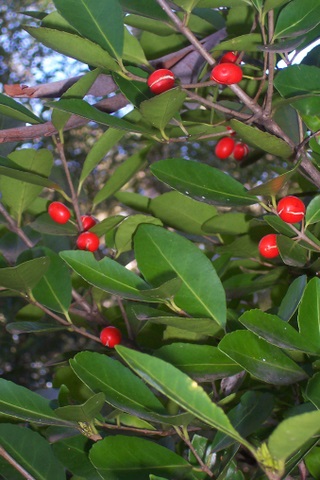Elaeodendron Australe on:
[Wikipedia]
[Google]
[Amazon]

 ''Elaeodendron australe'', commonly known as red olive-berry, red-fruited olive plum, or blush boxwood, is a species of flowering plant in the family
''Elaeodendron australe'', commonly known as red olive-berry, red-fruited olive plum, or blush boxwood, is a species of flowering plant in the family
 ''Elaeodendron australe'', commonly known as red olive-berry, red-fruited olive plum, or blush boxwood, is a species of flowering plant in the family
''Elaeodendron australe'', commonly known as red olive-berry, red-fruited olive plum, or blush boxwood, is a species of flowering plant in the family Celastraceae
The Celastraceae (staff-vine or bittersweet) are a family of 97 genera and 1,350 species of herbs, vines, shrubs and small trees, belonging to the order Celastrales. The great majority of the genera are tropical, with only ''Celastrus'' (the sta ...
and is endemic
Endemism is the state of a species being found in a single defined geographic location, such as an island, state, nation, country or other defined zone; organisms that are indigenous to a place are not endemic to it if they are also found else ...
to eastern Australia. It is a shrub or small tree with egg-shaped to oblong leaves with a wavy margin, yellowish green male and female flowers on separate plants and fleshy orange-red fruit.
Description
''Elaeodendron australe'' is a shrub or small tree that typically grows to a height of and has separate male and female plants. The leaves are mostly arranged in opposite pairs and are egg-shaped to elliptic or oblong with a wavy edge, long and wide on a petiole long. ''Elaeodendron australe'' is dioecious; that is, male and female flowers are borne on separate plants. The flowers are arranged in cymes in leaf axils, on a peduncle up to long, each flower on apedicel
Pedicle or pedicel may refer to:
Human anatomy
*Pedicle of vertebral arch, the segment between the transverse process and the vertebral body, and is often used as a radiographic marker and entry point in vertebroplasty and kyphoplasty procedures
...
long. The four petals are yellowish-green, about long. Male flowers have four stamens and female flowers have four staminodes. Flowering occurs in spring and summer and the fruit is a fleshy, oblong to oval, orange-red drupe long. The fruit is ripe from March to July and often persists on the tree for many months.
Taxonomy
''Elaeodendron australe'' was first formally described in 1805 byÉtienne Pierre Ventenat
Étienne Pierre Ventenat (1 March 1757 – 13 August 1808) was a French botanist born in Limoges. He was the brother of naturalist Louis Ventenat (1765–1794).
While employed as director of the ecclesiastic library Sainte-Geneviève in Paris ...
in his book '' Jardin de la Malmaison''.
In 1825, de Candolle
Augustin Pyramus (or Pyrame) de Candolle (, , ; 4 February 17789 September 1841) was a Swiss botanist. René Louiche Desfontaines launched de Candolle's botanical career by recommending him at a herbarium. Within a couple of years de Candolle ...
described two varieties in ''Prodromus Systematis Naturalis Regni Vegetabilis
''Prodromus Systematis Naturalis Regni Vegetabilis'' (1824–1873), also known by its standard botanical abbreviation ''Prodr. (DC.)'', is a 17-volume treatise on botany initiated by Augustin Pyramus de Candolle. De Candolle intended it as a summa ...
'' and the names are accepted by the Australian Plant Census The Australian Plant Census (APC) provides an online interface to currently accepted, published, scientific names of the vascular flora of Australia, as one of the output interfaces of the national government Integrated Biodiversity Information Syst ...
:
* ''Elaeodendron australe'' Vent. var. ''australe'' that has leaves less than four times as long as broad, and mostly more than wide;
* ''Elaeodendron australe'' var. ''integrifolium'' ( Tratt.) DC. (previously known as ''Portenschlagia integrifolia'') that has leaves more than four times as long as broad, and less than wide.
Distribution and habitat
Red olive-berry grows ineucalypt
Eucalypt is a descriptive name for woody plants with capsule fruiting bodies belonging to seven closely related genera (of the tribe Eucalypteae) found across Australasia:
''Eucalyptus'', ''Corymbia'', ''Angophora'', '' Stockwellia'', ''Allosyn ...
and rainforest ecotone
An ecotone is a transition area between two biological communities, where two communities meet and integrate. It may be narrow or wide, and it may be local (the zone between a field and forest) or regional (the transition between forest and gras ...
areas, and in littoral
The littoral zone or nearshore is the part of a sea, lake, or river that is close to the shore. In coastal ecology, the littoral zone includes the intertidal zone extending from the high water mark (which is rarely inundated), to coastal a ...
or dry rainforest. It is found in north-eastern and central eastern Queensland and as far south as Tuross Head in New South Wales. An unusual thick-leaved form occurs in Mount Kaputar National Park
The Mount Kaputar National Park is a national park located in New South Wales, Australia, surrounding the proximities of Mount Kaputar, a volcano active between 17 and 21 million years ago. It is located east of Narrabri and northwest of ...
and nearby western slopes and dry tableland gorges.
Use in horticulture
Seed germination is very slow, but reliable with around a 25% success rate after twelve months.References
{{Taxonbar, from=Q5353115 australe Sapindales of Australia Flora of Queensland Flora of New South Wales Plants described in 1805 Taxa named by Étienne Pierre Ventenat Dioecious plants